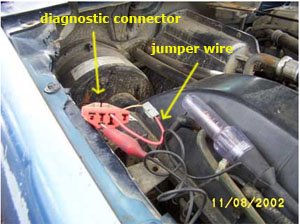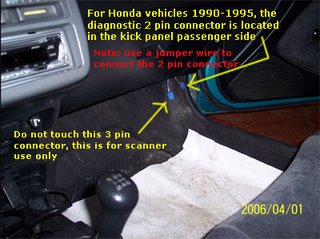When checking engine service light on Ford vehicles made before 1995, you can get the code yourself using a $5 tool called "test light". All you need is to hook it up to the vehicle’s diagnostic connector and turn your key on and watch the codes being flashed in your dash panel.
Here's how the connector is set up below:

You should find the diagnostic connector under your hood normally by the fender on the battery side. By just using your test light and a jumper wire, it will tell you what kind of problem you got.
KEY ON ENGINE OFF (KOEO) TEST1. Make sure engine is fully warmed. If in doubt, run engine at 2000 rpm for 2 minutes.
2. Turn ignition off and wait 10 seconds for system to shut off. Make sure A/C is off and transmission is in Park (automatic) or Neutral (manual).
3. Hook up light and jumper (or a tester if you have one). Turn key to ON (do not start engine). Read the codes.
How to do it?Example code 23: your test light should flash 2 long consecutive flashes followed by 3 short pulses.
Ford's common codes for OBD1 (vehicles made before 1995)11 system pass
12 idle control fault
13 dc motor did not move
14 engine rpm signal fault or PIP circuit failure
15 eec processor or power to KAM interrupted
16 rpm to low to check oxygen sensor test or fuel control error
17 cfi fuel control system fault or rich/lean condition indicated
18 ignition diagnostic monitor (IDM) circuit failure
19 cylinder identification (CID) sensor input failure
21 engine coolant temperature (ECT) out of self-test range
22 manifold absolute pressure (MAP) sensor circuit out of range
23 throttle positioner sensor out of self-test range
24 air charge temperature (ACT) sensor out of self-test range
25 knock not sensed during dynamic response test
26 transmission fluid temperature out of self-test range
28 loss of primary tach, right side
29 insufficient input from vehicle speed sensor
31 egr positioner sensor below minimum voltage
32 egr positioner sensor below closed limit
33 throttle positioner sensor noisy/harsh on line
34 egr valve circuit out of self-test range
35 egr valve circuit above maximum voltage
38 idle track switch circuit open
39 axod torque converter or bypass clutch not applying properly
41 oxygen sensor circuit indicates system always lean
42 oxygen sensor circuit indicates system always rich
43 oxygen sensor out of self-test range
44 air injection control system failure
45 coil 1 primary circuit failure
46 coil primary circuit failure
47 4X4 switch is closed or oxygen sensor failure
48 coil primary circuit failure
49 electronic transmission shift error
51 engine coolant temperature sensor circuit open
52 power steering pressure switch circuit open
53 throttle position circuit above maximum voltage
54 air charge temperature circuit open
55 key power input to processor open circuit
56 mass air flow circuit above maximum voltage
57 axod circuit failure
58 idle tracking switch circuit fault
59 automatic transmission shift error
61 engine coolant temperature circuit grounded
62 converter clutch error
63 throttle positioner circuit below minimum voltage
64 air charge temperature circuit grounded
65 charging system over voltage
66 mass air flow sensor circuit below minimum voltage
67 neutral/drive switch circuit open
68 transmission fluid temperature over temperature range
69 transmission shift error
70 data circuit communication link circuit failure
71 message center circuit circuit failure
72 insufficient manifold absolute pressure (MAP) change during dynamic response test
73 insufficient throttle positioner (TPS) change during dynamic response test
74 brake on/off (BOO) circuit open
75 brake on/off (BOO) circuit closed
76 insufficient air flow output change during test
77 brief wide open throttle not sensed during test
78 power interrupt detected
79 a/c on/defrost on during self test
81 map has not changed normally
82 super charger bypass circuit failure
83 OIC-low speed fuel pump relay circuit failure
84 egr vacuum regulator (EVR) circuit failure
85 canister purge circuit failure
86 shift solenoid circuit failure
87 fuel pump circuit failure
88 electro drive fan circuit failure
89 transmission solenoid circuit failure
91 no oxygen sensor switching detected
92 shift solenoid circuit failure
93 throttle positioner sensor input low
94 torque converter clutch solenoid circuit failure
95 fuel pump secondary circuit failure
96 fuel pump secondary circuit failure
97 transmission indicator circuit failure
98 electronic pressure control circuit failure
99 eec has not learned to control idle
Note:The above codes must be verified before replacing any parts. Contact ATS and we will give you the test and fixes for the code.













